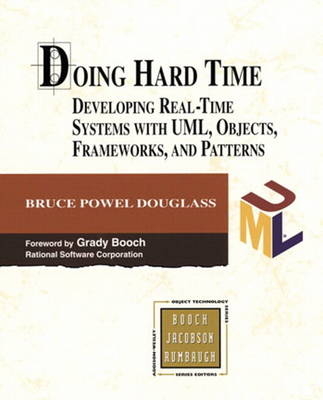
Doing Hard Time
Addison-Wesley Educational Publishers Inc (Verlag)
978-0-321-77493-4 (ISBN)
- Titel ist leider vergriffen;
keine Neuauflage - Artikel merken
Bruce Powel Douglass is the Chief Evangelist for i-Logix, a leading producer of tools for real-time systems development. He contributed to the original specification of the UML and to the UML 2.0 as one of the co-chairs of the Object Management Group’s Real-Time Analysis and Design Working Group. Bruce consults for a number of companies and organizations, including NASA, on building large-scale, real-time, safety-critical systems. He is the author of seven other books, including Real-Time Design Patterns (Addison-Wesley, 2003) and Doing Hard Time (Addison-Wesley, 1999).
(Chapters begin with an Introduction and conclude with a Summary, Looking Ahead, Exercises and References.)
Figure List.
About the Author.
Preface.
Acknowledgments.
SECTION 1: BASICS.
1. Introduction to Objects and the Unified Modeling Language.
Advantages of Objects.
Terms and Concepts.
Object Orientation with UML.
Objects.
Attributes.
Behavior.
Messaging.
Responsibility.
Concurrency.
Objects as Autonomous Machines.
Class Diagrams.
Relations Among Classes and Objects.
Use Cases.
Sequence Diagrams.
Physical Representation.
Things Common to Diagrams.
Notes.
Packages.
Constraints.
Stereotypes.
2. Basic Concepts of Real-Time Systems.
What is Real-Time?
Terms and Concepts.
Timeliness.
Responsiveness.
Concurrency.
Scheduling Concurrent Threads.
Event Arrival Patterns.
Thread Rendezvous Patterns.
Sharing Resources.
Predictability.
Memory Management.
Correctness and Robustness.
Deadlock.
Exceptional Conditions.
Race Conditions.
Distributed Systems.
Fault Tolerance and Safety.
Dealing with Resource-Limited Target Environments.
Low-Level Hardware Interfacing.
Real-Time Operating Systems.
Scalability.
Scheduling.
Typical RTOS Features.
3. Basic Concepts of Safety-Critical Systems.
Introduction to Safety.
The Therac-25 Story.
Other Stories.
Terms and Concepts.
Safety Related Faults.
Safety is a System Issue.
Random Faults Versus Systematic Faults.
Single Point Failures.
Common Mode Failures.
Latent Faults.
Fail-Safe State.
Achieving Safety.
Safety Architectures.
Single Channel Protected Design.
Eight Steps to Safety.
Step 1: Identify the Hazards.
Step 2: Determine the Risks.
Step 3: Define the Safety Measures.
Step 4: Create Safe Requirements.
Step 5: Create Safe Design.
Step 6: Implementing Safely.
Step 7: Assure Safety Process.
Step 8: Test, Test, Test.
Few Safety Related Standards.
4. Rapid Object-Oriented Process for Embedded Systems.
Terms and Concepts.
Development Phases.
Ordering.
Maturity.
Development Task Sequencing.
Waterfall Lifecycle.
Iterative Lifecycles.
Prototyping.
Scheduling and Estimation.
Advantages of Accurate Schedules.
Difficulties of Accurate Scheduling.
The ROPES Macro Cycle.
Analysis.
Requirements Analysis.
Systems Analysis.
Object Analysis.
Design.
Architectural Design.
Mechanistic Design.
Detailed Design.
Translation.
Activities.
Artifacts.
Testing.
Activities.
SECTION 2: ANALYSIS.
5. Requirements Analysis of Real-Time Systems.
Terms and Concepts.
Use Cases.
Messages and Events.
Scenarios, Protocols, and State Machines.
Use Cases.
Use Case Relations.
Use Case Example: Air Traffic Control System.
External Events.
Context-Level Messages.
Specifying External Messages.
External Event List.
Response Time.
Detailing Use Case Behavior.
Informal Textual Description.
Scenarios.
Sequence Diagrams.
Statecharts for Defining Use Case Behavior.
Identifying Use Cases.
Using Use Cases.
Heuristics for Good Requirements Analysis Diagrams.
Use Case Diagram Heuristics.
Use Case Heuristics.
Use Case Sequence Diagram Heuristics.
6. Structural Object Analysis.
Terms and Concepts.
Key Strategies for Object Identification.
Underline the Noun.
Identify Causal Agents.
Identify Coherent Services.
Identify Real-World Items.
Identify Physical Devices.
Identify Essential Abstractions of Domains.
Identify Transactions.
Identify Persistent Information.
Identify Visual Elements.
Identify Control Elements.
Execute Scenarios on the Object Model.
Reification of Objects into Classes.
Identify Object Associations.
Multiplicity.
Associations and Links.
Aggregation and Composition.
Object Attributes.
Generalization Relationships.
AATCS Example: Class Diagrams.
Heuristics for Good Class Diagrams.
Rules for Good Class Diagrams.
7. Object Behavioral Analysis.
Terms and Concepts.
Simple Behavior.
State Behavior.
Continuous Behavior.
UML Statecharts.
Basic State Semantics.
Transitions and Events.
Actions and Activities.
Pseudostates.
Orthogonal Regions and Synchronization.
Basic Statechart Syntax.
Inherited State Models.
Ill-formed State Models.
Example: AATCS Alarm System.
The Role of Scenarios in the Definition of Behavior.
Timing Diagrams.
Sequence Diagrams.
Activity Diagrams.
Defining Operations.
Types of Operations.
Strategies for Defining Operations.
Statechart Heuristics.
Timing Diagram Heuristics.
Activity Diagram Heuristics.
SECTION 3: DESIGN.
8. Architectural Design.
Terms and Concepts.
Tasking Model.
Representing Tasks.
Defining Task Threads.
Assigning Objects to Tasks.
Defining Task Rendezvous.
Component Model.
Deployment Model.
Representing Physical Architecture in the UML.
Multiprocessor Systems.
Safety/Reliability Model.
9. Mechanistic Design.
Terms and Concepts.
Design Pattern Basics.
Mechanistic Design Patterns.
Correctness Patterns.
Execution Control Patterns.
10. Detailed Design.
Introduction to Detailed Design.
Terms and Concepts.
Data Structure.
Primitive Representational Types.
Subrange Constraints.
Derived Attributes.
Data Collection Structure.
Associations.
The Object Interface.
Definition of Operations.
Detailed Algorithmic Design.
Representing Algorithms in the UML.
Algorithmic Example: Run-Time Data Interpolation.
Exceptions.
Source Language-based Exception Handling.
State-based Exception Handling.
SECTION 4. ADVANCED REAL-TIME MODELING.
11. Threads and Schedulability.
Terms and Concepts.
Time-Based Systems.
Reactive Systems.
Time Concepts.
Scheduling Threads.
Rate Monotonic Scheduling.
Earliest Deadline Scheduling.
Least Laxity Dynamic Scheduling.
Maximum Urgency First Scheduling.
Weighted Shortest Processing Time First (WSPTF) Scheduling.
Minimizing Maximum Lateness Scheduling.
Thread Synchronization and Resource Sharing.
Mutual Exclusion Semaphore.
Dekker's Algorithm.
Spinlocks.
Counting Semaphores.
Condition Variables.
Barriers.
Rendezvous Objects.
Schedulability Analysis of Hard Real-Time Systems.
Global Analysis.
Global Method with Blocking.
Computing Blocking.
Separate Task Utilization Bounds.
Aperiodic Tasks.
Schedulability Analysis of Soft Real-Time Systems.
Warm and Fuzzy: Timeliness in the Soft Context.
Soft Schedulability.
12. Dynamic Modeling.
Terms and Concepts.
But is it the Right State Machine?
Behavioral Patterns.
Latch State Pattern.
Polling State Pattern.
Latched Data Pattern.
Device Mode State Pattern.
Transaction State Pattern.
Component Synchronization State Pattern.
Barrier State Pattern.
Event Hierarchy State Pattern.
Random State Pattern.
Null State Pattern.
Watchdog State Pattern.
Retriggerable Counter State Pattern.
Model-Level Debugging and Testing.
Animated Debugging.
Animated Testing.
Sample Debugging Session.
13. Real-Time Frameworks.
Terms and Concepts.
Real-Time Frameworks.
Architectural Support Patterns.
Safety and Reliability Patterns.
Behavioral Patterns.
Framework Design Principles and Metrics.
Set of Services.
Generalization Hierarchy Structure.
Replaceable Components.
Portability.
Naming and Syntax Conventions.
Performance.
The Rhapsody Object Execution Framework (OXF).
Rhapsody Architecture.
Execution Framework.
Interobject Association Patterns.
Using C++ Standard Template Library.
Abstract Operating System.
Animation Framework.
Sample Application Using the Rhapsody OXF Framework.
Appendix A: UML Notation Summary.
Appendix B: Introduction to Rhapsody.
Appendix C: Introduction to Timewiz.
Index.
CD-ROM Warranty. 0201498375T04062001
| Erscheint lt. Verlag | 5.9.2011 |
|---|---|
| Verlagsort | New Jersey |
| Sprache | englisch |
| Maße | 187 x 234 mm |
| Gewicht | 1350 g |
| Themenwelt | Informatik ► Software Entwicklung ► Objektorientierung |
| Informatik ► Software Entwicklung ► UML | |
| ISBN-10 | 0-321-77493-0 / 0321774930 |
| ISBN-13 | 978-0-321-77493-4 / 9780321774934 |
| Zustand | Neuware |
| Haben Sie eine Frage zum Produkt? |
aus dem Bereich


